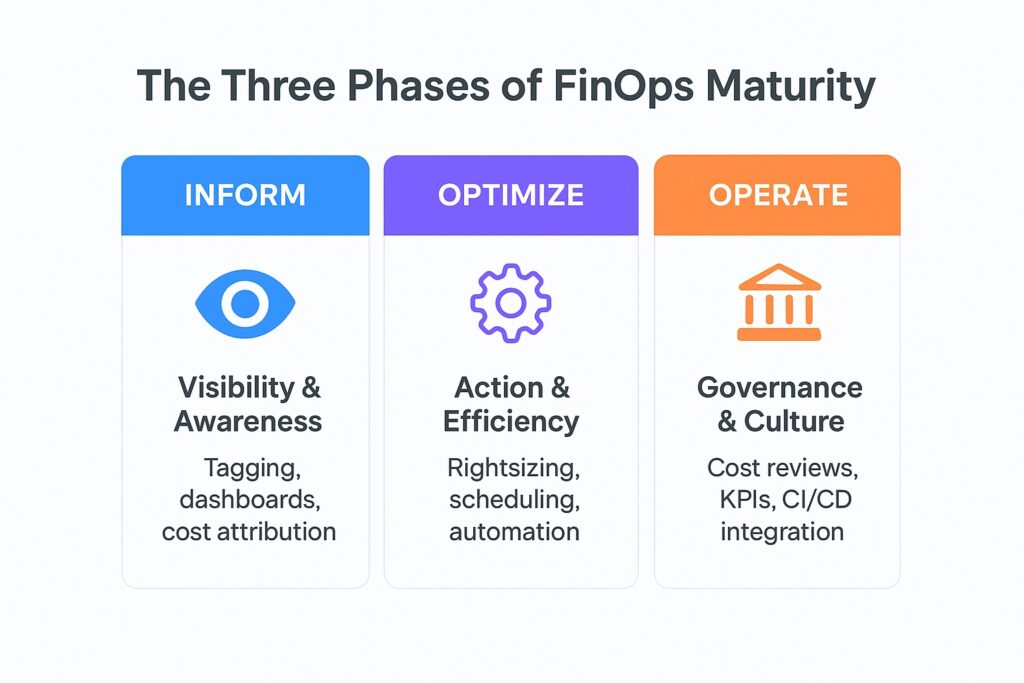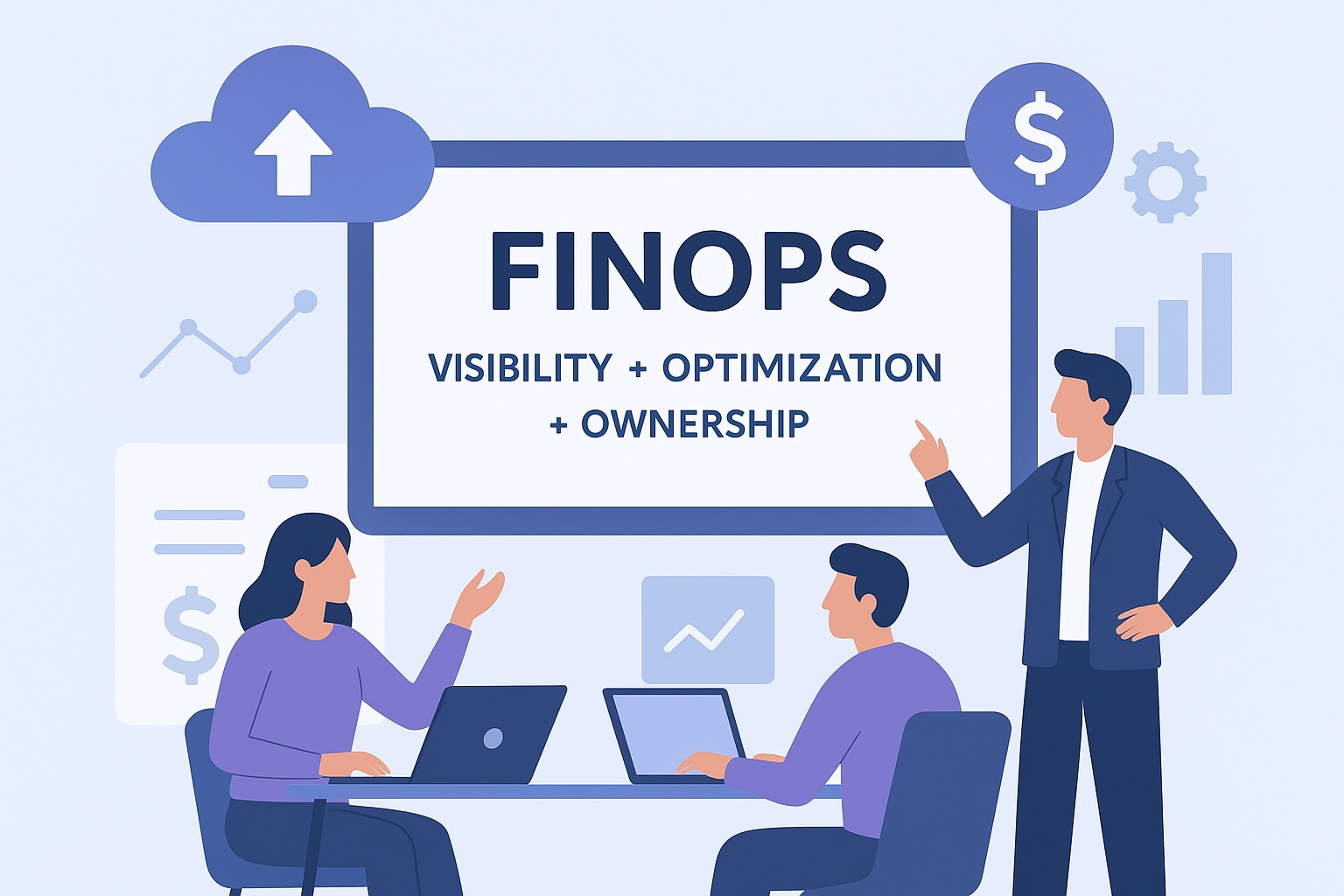A startup might celebrate its first cloud bill, proof of traction.
A scale-up might panic at its tenth, proof of chaos.
FinOps maturity is what separates reaction from control.
It’s the difference between managing cloud cost and mastering cloud value.
So, what is exactly FinOps Maturity?
It isn’t about saving money it’s about how well your organisation turns cloud spending into business value.
As defined by the FinOps Foundation, the FinOps Maturity Model has three progressive phases:
Inform → Optimize → Operate.
Each builds on the other like visibility before control, and control before culture.
1. INFORM Visibility and Awareness
“You can’t optimise what you can’t see.” – Anything you planning to improvise you will have to measure where you stand today and then set target to where you want to reach.
Target: Create visibility into cloud usage and cost.
How can we do that?
- Implement clear tagging and account structure.
- Build dashboards for spend by team, service, and environment.
- Run initial cost attribution and anomaly detection.
What is stopping us to achieve the target
- Poor tagging hygiene.
- Fragmented cloud accounts.
- Lack of ownership or accountability.
Food for thought: Can every team see what they’re spending and why?
When you reach this phase, you’re building the foundation. Everyone gets visibility, but few yet act on it.
2. OPTIMIZE Action and Efficiency
“Once you see the spend, you can start improving it.”
Target: Reduce waste and improve cost-efficiency.
How we can achieve it:
- Rightsize instances and storage.
- Schedule non-production environments.
- Use Reserved Instances or Savings Plans.
- Automate cost policies (shutdowns, alerts).
What is stopping us to achieve it:
- Engineering resistance to change.
- Lack of incentives for cost ownership.
- Manual processes that don’t scale.
Food for thought: Are teams empowered to act on cost data and do they?
This is where FinOps shifts from insight to impact. Teams learn that cloud cost optimisation isn’t about cutting it’s about smart engineering.
3. OPERATE Governance and Culture
“At this stage, FinOps stops being a project and starts being a practice.”
Target: Institutionalise FinOps as a continuous habit and shared culture.
How we can achieve it:
- Hold monthly cost reviews with cross-functional teams.
- Tie KPIs to business outcomes (e.g., cost per feature or per customer).
- Embed FinOps into CI/CD, architecture, and product planning.
- Offer training and incentives for cost-aware behaviour.
What is stopping us to achieve it
- Siloed ownership and unclear accountability.
- Lack of leadership buy-in.
- No feedback loop between optimisation and planning.
Food for thought: Is FinOps part of your delivery lifecycle or just a finance report?
Here, FinOps becomes woven into decision-making it’s not about cloud cost anymore, but business velocity.
How to Benchmark Your Organisation
Use this quick checklist to assess where you are:
- We have tagging standards and dashboards for cloud spend.
- Teams receive monthly cost reports and know their top drivers.
- We’ve implemented rightsizing and scheduling policies.
- Cost KPIs are part of product or engineering OKRs.
- FinOps is discussed in sprint planning or release reviews.
If you checked:
- 1–2 items: You’re in Inform.
- 3–4 items: You’re in Optimise.
- All 5: You’re approaching Operate.
Please note: FinOps maturity is a journey not a checklist. Move one phase at a time, with intent.
What is going to stop you?
Skipping Inform: Trying to optimise without visibility leads to blind decisions.
Over-centralising: FinOps thrives when cost ownership is distributed.
Treating FinOps as finance-only: It must live within engineering and product.
No feedback loop: Without learnings feeding into future planning, optimisation becomes firefighting.
Take away: FinOps is less about tools more about transparency and trust.
FinOps maturity isn’t a finish line it’s a capability curve. Being aware is good start to where you want to be. The goal isn’t perfection, but progress: better visibility, smarter trade-offs, and shared accountability.
Start where you are.
Build visibility → Empower action → Embed governance.
That’s how FinOps evolves from a cost-control tool into a strategic business advantage. Where is your team on the FinOps maturity curve?
Drop a comment or DM me I’d love to hear your story.
#FinOps #CloudFinance #CloudOptimization #DigitalTransformation #CloudGovernance #FinOpsMaturity #ProjectManagement #TechLeadership




